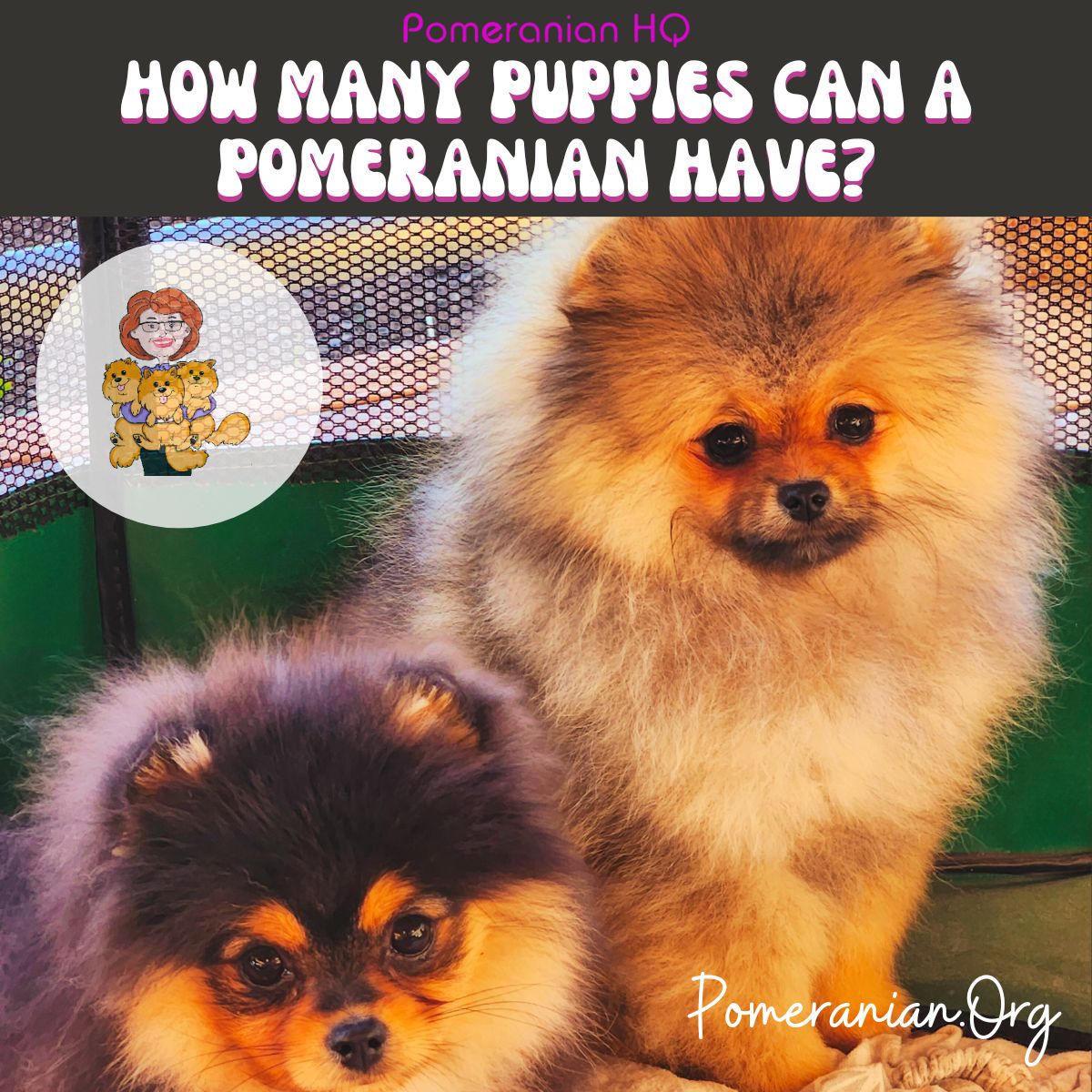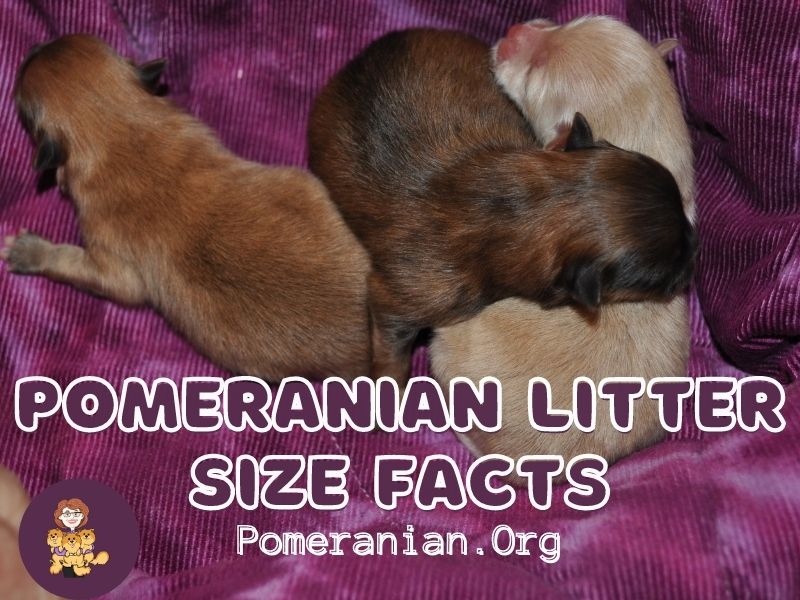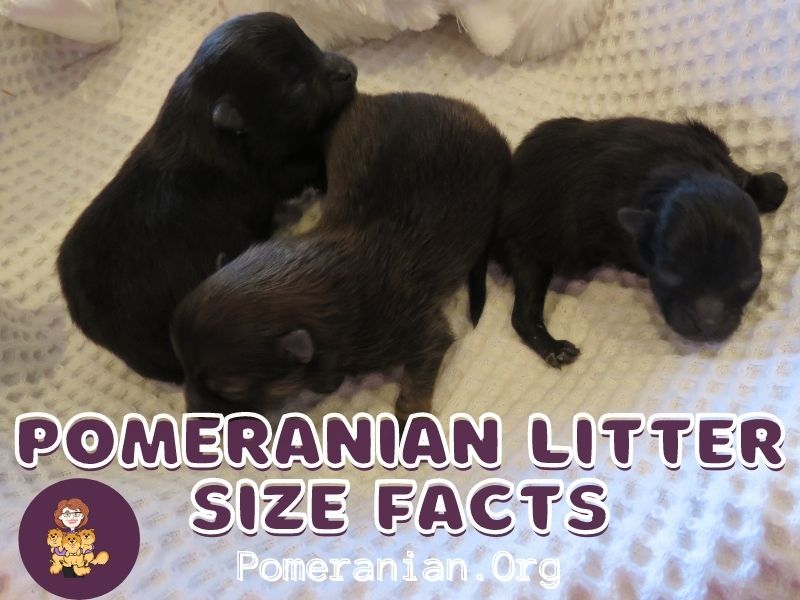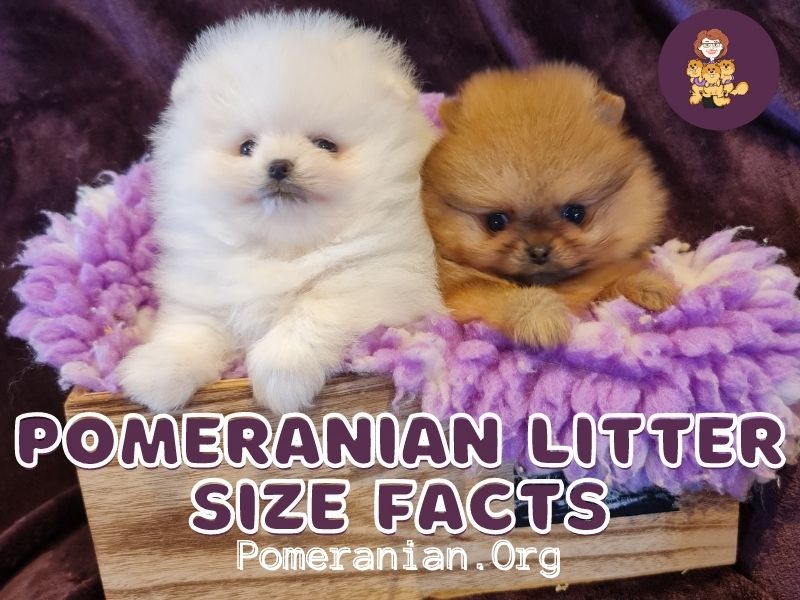Last Updated on 28/04/2024 by Denise Leo. Post first published on October 3, 2023.
This article is authored by Denise Leo of Dochlaggie Pomeranians, renowned for her extensive Pomeranian breeding experience, in collaboration with our resident veterinarian, Dr. Muqeet Mushtaq. Dr. Mushtaq holds a DVM from the University of Animal and Veterinary Sciences (2019) and an MSc (Hons.) in Animal Breeding & Genetics from the University of Agriculture Faisalabad (2021).
With a successful track record in breeding Pomeranians since 1975, Denise shares her invaluable hands-on experience and insights into Pomeranian breeding.
Pomeranian puppies are a cute new addition to any family. They have fluffy, soft fur, and their little faces make you want to squish them against your face. Pomeranians are a small dog breed.
Discover the typical litter size for Pomeranians and learn what factors influence the number of puppies they can have.
The average size litter for small dogs like Pomeranians ranges from one puppy to three puppies. However, sometimes they can produce a litter of up to 5 pups. In some rare cases, the Pomeranian litter size can be six or seven puppies.
It’s always hard to guess how many will be born because it varies from Pomeranian dog to dog and sometimes even depends on their age at conception. Some might only give birth once or twice, while others may go into labor as often as every year if they aren’t spayed/neutered before breeding starts.
Many different factors determine the litter size of a Pomeranian. Here, we will discuss in detail how many puppies a Pomeranian can have. How many Puppies can a Pomeranian have in one litter and other things related to their litter?

When Can You Get To Know The Size Of Litter?
When expecting a litter of puppies, it can be difficult to know exactly how many are on the way. There isn’t one simple answer to this question. Different methods exist that will help predict how many puppies she will have, although none is perfect by any stretch of the imagination.
You might not have to wait so long. Some dogs will let you know they’re pregnant in as little as 21 days, but it’s best to be safe and start looking after 25 or 26 days of the pregnancy at how many pups your Pomeranian has.
When you touch your dog’s uterus, you will feel lumps and bumps; these are puppies’ heads, and you can try counting them. But remember, you’re trying to count something that’s only the size of an eraser head so that it could be anything from one puppy up to 6 puppies in there, all bunched together like sardines.
It’s not always easy because they are usually squirming around as well, but don’t worry about counting too slowly or skipping any numbers since this new litter will have its way of telling us what number they are if we give them enough time.
If you want to know how many puppies are there, the vet is your guy. They can count them for you and tell you what’s going on down south with all that bumping inside.
Asking your vet to do an ultrasound is the best way to determine how many puppies you expect. They will be able to tell when it’s time and give a better idea of what kind of birth plan might work best.
But, if you want X-ray readings, you must wait for the 55th day of pregnancy. That’s because puppies move around a lot less during this time. It is easier for vets in radiology departments specializing in prenatal care to identify what parts they have grown into.
How Many Puppies Do Pomeranians Have In One Litter?
Most people think that a dog’s age plays no role in how many puppies they can produce, but it affects their reproductive capacity—the dog’s age, when breeding, plays a key part in litter size.
Female Pomeranians over three years can have larger litters than younger mothers, whose bodies regenerate more quickly. Despite this rule, there will always be exceptions where older girl Pomeranians may not reproduce as well as younger females with higher fertility rates.
It’s no secret that age significantly impacts the size of one’s offspring. Despite this, it seems there is more to be said about how dams’ ages affect their litters, whether they are first-time mothers or not.
The most puppies are usually born to mothers around the age of 2 to 5. However, the first two litters always have fewer puppies.
According to a recent study, many dog owners are unaware of how much their dog will change during pregnancy; some never realize until they’re in labor with multiple puppies. The research showed that 3rd and 4th pregnancies were generally the largest because dogs have the most puppies in these pregnancies.

What Factors Influence Pomeranian Litter Size?
In this section, we’ll explore the main factors that influence the size of a Pomeranian litter:
Dam’s Age
Generally, the size of a litter decreases as the damages. Interestingly, the first one or two litters are often smaller than the later ones; thus, you may see an increase of one or two puppies per litter after the initial litters.
It’s crucial to recognize that breeding a dog past seven or eight is not advisable. Breeding at this later stage can be risky, potentially causing health complications for both the mother and the puppies.
For the health and well-being of your dog, it is recommended that she be spayed well before reaching this age. This prevents late-life pregnancies and contributes to a healthier life for your dog.
Sire’s Age
The sire of your Pom’s litter can also influence the number of puppies, though his impact is generally less significant than that of the dam.
Despite a highly fertile female, the litter size might still be smaller if the male dog’s sperm quality begins to decline, which typically starts around the age of 5 to 6 years. Consequently, breeders sometimes resort to artificial insemination to successfully breed older males. Therefore, breeding male dogs when younger is advisable to optimize litter size and health.
Dam’s Health
A puppy’s health is intrinsically linked to the health of its mother. Prioritizing a dog’s mental and physical well-being is crucial before breeding. This means providing ample love, exercise, and mental stimulation to ensure she is in optimal condition.
Moreover, the nutrition of the dam significantly affects litter size. To enhance the chances of a larger litter, it’s important to maintain a year-round diet that is high in quality and rich in protein.
Conversely, dams fed a poor diet, particularly those overweight, tend to produce smaller litters. Proper nutritional management is key to promoting the mother’s health and her puppies’ vitality.
Mother’s Size
Rather than body weight, larger body frames correlate with bigger litter sizes within a specific breed.
As a small breed, Pomeranians physically cannot have as many puppies as larger breeds, such as Huskies, can. Generally, Pomeranians with slightly larger frames may produce somewhat bigger litters, but this is a minor factor considering the minimal size variation among individuals in the breed.
Size of Litter From Which The Mother Originated
The fertility of your Pomeranian can be influenced by the size of the litter they were born into. She would likely have a larger first litter herself if she were part of a large litter. Conversely, if she originated from a smaller litter, you can expect her also to have a smaller first litter. This pattern often provides some insight into the reproductive traits she may pass on.
Breeding Method
The breeding method employed often holds significant sway, such as the distinction between natural mating and artificial insemination performed at your veterinarian’s office.
Breeding Timing
Breeding timing is often discussed, suggesting that a dam is likelier to have a larger litter size when closer to ovulation. This phase occurs after the estrogen period is triggered by the Luteinizing hormone. However, despite this belief, there needs to be more supporting studies. As a result, the significance of this factor remains uncertain at this time.
Inbreeding
If inbreeding is too intensive, it can negatively affect the quality of a litter. Not only can it lead to smaller litter sizes, but it can also lead to shorter life expectancies and heightened susceptibility to genetic disorders in the puppies. The likelihood of these issues increases as the genetic relationships between the breeding dogs become closer.
Is The First Litter Of Puppies The Largest?
When they breed, a dog’s age plays an important role in the size and number of their litter. 2 to 5-year-old dogs usually have the largest, with first litters being smaller than those that follow them regardless (though they’re still pretty big). On average, 3rd and 4th pregnancies are typically larger than others.
Is The First Or Second Litter The Best?
Several factors go into determining the number of puppies in a litter. One such factor is age: as dogs get older, they have fewer litters, and their litters become smaller, too.
For example, dogs bred between ages 2 and 5 typically give birth to larger pups than those aged 6+ years old. Nevertheless, there may still be some exceptions among small-breed females.
How Many Litters Can A Pomeranian Have In A Year?
To abide by most Kennel Club rules, your Pomeranian can only have one litter yearly. In some circumstances, two litters in 18 months are permitted.
Can Pomeranians Have 6 Puppies?
Pomeranians are well known for being tiny balls of energy. And it’s not just their size that sets them apart from the other breeds, but also how many babies they can make in a single litter! Most litters will have all puppies surviving, and most would only be 1-3 little ones, sometimes even producing up to 6 pups.
There is no set number of puppies Pom can have. The number of puppies she has in her litter may depend on her size and health and those around her at that time.
Is The First Puppy Born The Biggest?
There are no rules regarding puppy birth orders. The largest may be born first, last, or in the middle, and the same with the smallest. It is common for the largest, first-born pup to be smaller than its last-born sibling. The same goes for a dog’s smallest; it does not always get left out regarding nursing.

How Can You Tell How Many Puppies A Pom Is Having?
The only way to know how many puppies your dog will have is through a veterinarian. Your vet can estimate the size of the litter with palpation, ultrasound, or x-rays and tell you how many puppies your Pom will have.
Can A Pomeranian Be Pregnant For 70 Days?
The question of how long Poms are pregnant or when they give birth is common. The term “gestation” refers to the time from conception until birth. It’s typically around 63 days. The first three weeks of a Poms pregnancy will not show any signs that she is carrying puppies.
Is The Second Litter Of Puppies The Best?
Female dogs are most fertile after they turn 2. However, this fertility decreases when a female is four and can end altogether by five. If you want your Pomeranian offspring to be healthy, it is best for them not only to have litters of average size. But also live long enough so that they may breed early in their life cycle while still being able to give birth often!
Female dogs are very fertile when young (around age two), but fertility starts decreasing rapidly after four, with females often becoming infertile by about seven or eight on average.
Is The Biggest Puppy In The Litter The Healthiest?
The largest of the litter may grow to be a large dog, but a dog with more nutrients would likely outgrow its smaller siblings. Nutrition in childhood will have lasting effects on an individual’s physical shape throughout life and can even cause irreversible damage if not taken care of early enough.
Puppies that are underfed at young ages may never develop correctly or catch up later in life, leading them to experience stunted growth potential as adults.

How Many Puppies Is Normal For A First Litter?
There is a huge variation in the size of litter that dogs can have, from one to six. According to Guinness, the world record for most litters was twenty-four puppies by a Neapolitan Mastiff in 2004.
Puppies are a bundle of joy and love but come in all sizes. Some puppies can have as many as twelve brothers or sisters, but this is impossible for Pomeranians or other toy breeds.
Twelve puppies are not a typical litter size, but it is possible. The average number of puppies in the first litter of Pomeranian dogs can range from 1 to 3, with 5 to 6 being born in rare cases.
How Big Are Pomeranian Puppies At Birth?
Pomeranian puppies are tiny! They’re usually between 2 and 5 ounces at birth but typically grow from 4-10 pounds.
Does A Pomeranian Belly Drop Before Labor?
The final stages of labor are when the cervix dilates, and your dog begins to push. The first sign that she is ready for delivery can be seen in her panting: shivering or acting restless; these signs may come up six hours before you see puppies moving around inside. You might also notice vomiting from time to time and a drooping belly.
How Big Is a Pomeranian Puppy at Birth?
A newborn Pomeranian, weighing a mere 3 to 6 ounces (85 to 170 grams), is a living testament to its extraordinary fragility and tininess. This underscores the crucial need for meticulous care and attention, particularly in their early life stages.
During this initial stage, puppies are exceptionally susceptible to infections and various health issues. This underscores the importance of being proactive and ensuring they receive immediate veterinary care, including their first vaccinations and necessary treatments.
Adult Pomeranians usually weigh between 3 and 7 pounds per the breed standard. However, it’s crucial to understand that their weight
can differ greatly because of diet, genetics, and activity levels. This underscores the need for personalized care for each Pomeranian.
How Many Litters Can a Pomeranian Have During Its Life?
Unlike humans, Pomeranians and all other dog breeds do not go through menopause and can reproduce throughout their lives. Typically, Pomeranians experience a heat cycle every 6 to 8 months, roughly twice yearly. Pomeranian females should not be bred before reaching 18 months of age.
While Pomeranians can breed frequently, it’s crucial to understand that this doesn’t benefit their health. In fact, for the well-being of the dogs, Pomeranians should ideally breed only two to four times in their lifetime and not more than twice within any 18 months. Overbreeding can place severe stress on a Pomeranian, potentially leading to significant health issues such as arthritis, infertility, and heart disease.
At Dochlaggie, we adhere to responsible breeding practices. Our females are limited to only two or three litters before being spayed, ensuring they can lead joyful and comfortable lives even after their breeding days.
Moreover, it’s important to note that in many countries, legal restrictions limit the number of times a dog can be bred across their lifespan, typically four to six times. This regulation underscores the critical importance of responsible breeding practices to prevent overbreeding and ensure the dogs’ health.
Why Should You Not Have Two Puppies From The Same Litter?
Some people believe that it is better to adopt two pups from different litters because they will bond more closely with their new family than each other. However, most experts disagree and say this has no bearing on how well a pup remembers its past since puppies are already socialized during important phases of development before adoption.
Some people like to adopt two dogs, but not from the same litter, so they won’t get too close as siblings who might grow up thinking only about each other instead of bonding with their human counterparts in addition to one another. This intuitively makes sense for some adopting parents, especially when considering the early stages where human contact may be limited.

Can A Pomeranian Have 15 Puppies?
The average number of puppies in a litter varies depending on the size and breed. Small breeds could have less than three puppies, while large dog breeds are likelier to produce 7 or 8 offspring at once. Scientists have discovered that the average number of puppies in a litter may vary depending on their mother’s size.
Some breeds only give birth to 1 or 2, while others can produce up to 15! Large dogs usually have around seven pups, but it’s not uncommon for them to be born with 12+. But Pomeranians can give birth to as many as six puppies in one litter.
Caring for your Pregnant Pomeranian
When a Pom is pregnant, taking an active role in her care is important. You should ensure she doesn’t have too much stress and gets plenty of rest during this time because small breeds are more prone to labor complications!
From the day you notice that she may be pregnant until she gives birth, some modifications will likely be necessary for both the dog and the owner.
It’s exceedingly important not to let your Pomeranian carry any excess weight while they’re pregnant. Remember that once they start going into labor or if their signs show something might happen soon, you’ll need someone around every moment.
It would be best if you were careful about what you feed her. Increasing her food intake is unnecessary, but giving her meals more often would be smarter. When she is born, you must also increase calcium-rich foods for healthy teeth and bones.
The vets know better than others about caring for a pregnant dam, so don’t hesitate to bring them with both mother and pup into the vet’s office as soon as they get there.

Welcoming your New Pomeranian Puppies
It’s been long, and you’re finally holding your little pup! But before celebrating too much, why not take the time to make sure all is well? While it may be hard with all that excitement bubbling up in momma-to-be mode, there are still some things for her new owner to learn. One of these first few tasks is ensuring no puppies are retained or stuck. They tend to happen more often in smaller breeds.
When your dog gives birth, it’s natural for her to bleed afterward. The occasional behavioral or physical change is also normal in puppies as they grow and develop into adults.
However, if anything seems off (even a little), don’t try to treat it yourself. Get mom-and-puppies back to the vet right away!
Everything is going well, but not all changes are normal. If you notice any unusual behavior or physical change in your dame and her puppies, bringing them to the vet instead of trying at home would be better.
Pomeranians always have the energy to keep you on your feet, and their loyalty is unrivaled. With one of these spunky pets, any owner can be satisfied with a single, but more would never hurt!
They are perfect companions for an energetic lifestyle or anyone who needs unconditional love from a pet. Their playful nature has no match in comparison, and they will shower you with affection all day long if given a chance!
Summing Up
In wrapping up our exploration of Pomeranian litter sizes, it’s evident that these small yet spirited canines have unique breeding characteristics.
Typically producing litters of 1 to 5 puppies, the size can be influenced by various factors, including the mother’s age, health, genetics, and even her previous litter history. Proper care, expert veterinary guidance, and understanding of the breed’s nuances are essential for ensuring healthy litters.
Potential breeders and Pomeranian enthusiasts should be informed about these facts to make the best decisions for the mother’s well-being and her pups.
As with any breeding endeavor, knowledge and preparedness are key to fostering the healthy growth and development of the next generation of these delightful dogs.
As you can see, many factors go into answering this question. Pomeranians are among the most popular breeds worldwide because they’re so adorable and cuddly.
I hope you’ve found this article helpful in your search for the answer to how many puppies a Pomeranian can have. If you are still wondering, please feel free to ask any questions.
Copyright Pomeranian.org. All Rights Reserved.
References and Further Reading:
[1] Official Standard of the Pomeranian (AKC). American Kennel Club, 2011.
[2] English Kennel Club Pomeranian Breed Standard, 2017.
[3] Denise Leo, The Pomeranian Handbook.
[4] Milo G. Denlinger “The Complete Pomeranian.”
[5] Kimbering Pomeranians “1891-1991”.
[6] William Taplin’s “The Sportsman’s Cabinet.”
[7] E. Parker “The Popular Pomeranian.”
[8] Lilla Ives “Show Pomeranians.”








